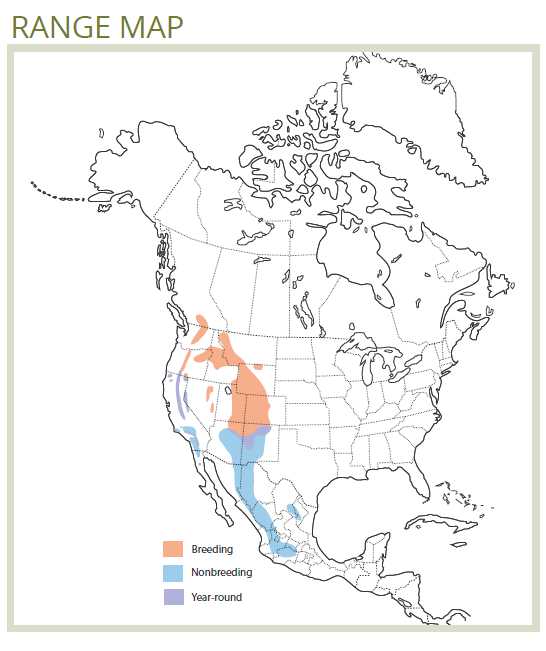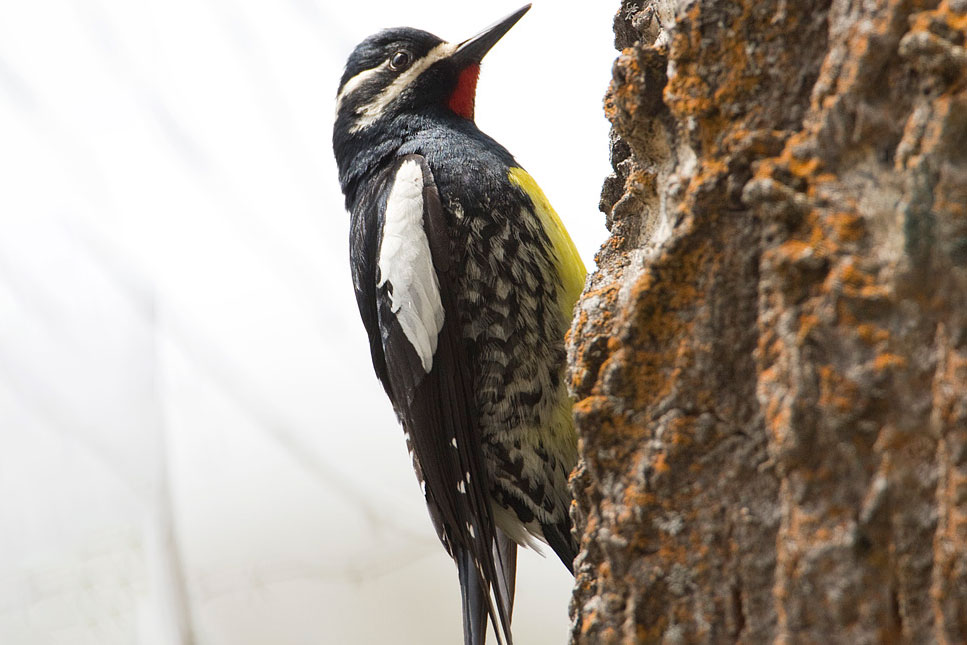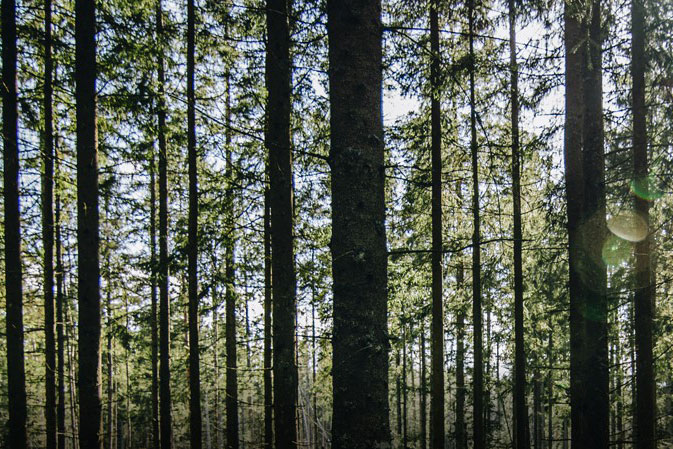Williamson’s Sapsucker
(Sphyrapicus thyroideus)
The Williamson’s Sapsucker is Endangered in Canada, and forest managers are responsible for ensuring their activities conform with federal and provincial regulatory requirements. The following species account provides a broad overview; however, the BC Ministry of Forests, Lands and Natural Resource Operations has produced region-specific habitat suitability models1 and best management practices within the Area of Occupancy of this species (see a list of documents at the end of this account).
Habitat Ecology
- The Williamson’s Sapsucker’s breeding range in Canada is limited to a very small area in south-central interior BC, which represents the northernmost tip of its range in North America.2
- This species breeds in mid- to high-elevation conifer and mixed conifer-deciduous forests including western larch, Douglas fir, ponderosa pine, and pine/fir forests. In these forests, the Williamson’s Sapsucker is positively associated with western larch and ponderosa pine.2
- The Williamson’s Sapsucker’s main habitat needs include nest trees, medium-sized trees for sap wells, and stumps, snags and logs containing ant colonies.2

- Nest trees are an important limiting factor for the Williamson’s Sapsucker, and preferred nest tree species vary according to forest type:
- In mixed coniferous-deciduous forests, trembling aspen is an important nest tree species, however aspen patches surrounded by non-forest are not used.2
- In mixed-conifer forests, large veteran western larch trees with heartrot are important nest trees. Suitable nest sites are located in late-seral stands containing 20–40 cm dbh Douglas fir and western larch trees, and containing old trees infested with carpenter ants (an important food source).3In sites without western larch, nests may be excavated in large-diameter aspen (avg. 35 cm dbh), ponderosa pine (avg. 72 cm dbh), and to a smaller degree, Douglas fir (avg. 72 cm dbh). Nest trees are located in sites meeting the description of the preceding bullet.4
- While this species does not typically reuse cavities, it frequently excavates new nests on trees containing old cavities.2
- The Williamson’s Sapsucker’s association with veteran trees means it is mainly found in old forests. For example, in the Okanagan-Greenwood population, most nests were found in stands >170 years old or containing western larch trees older than 170 years.3
Response to Forest Management
- Even-aged management under ~100-year rotations is a primary threat to the Williamson’s Sapsucker, as it entails removal of old veteran trees used for nesting and foraging, and removal of old forest stands used for foraging.3
- Williamson’s Sapsuckers will forage on logs in clearcuts, nest in snags 5–8 year-old burned stands, and use logged forests with 25% retention of trees and snags.2,4
- Notably, nests in retention harvests were always adjacent to mature or old stands, which the Williamson’s Sapsuckers used for foraging.4
Stand-level Recommendations
- The following habitat features are recommended for retention to provide future nesting and foraging habitat. Patches should be large enough to buffer nest trees (i.e., 100 m from high-impact activities) and ensure that nest trees will not need to be removed per WorkSafeBC regulations.5–7
- Trees containing cavities with 3–5 cm diameter openings (high probability of future nests on the same tree).2
- Large-diameter coarse woody debris for foraging.
- Large-diameter western larch located centrally within patches for wind-firmness. Absent western larch, large-diameter trembling aspen and/or ponderosa pine.
- Small-diameter Douglas fir for sap wells and several large-diameter trees for eventual snag development.
- A 100-m buffer is recommended for high-disturbance activities around confirmed or probable nests during the nesting season (generally from March 15 to July 15).5
- Region-specific BMPs (see below) recommend minimum targets for suitable and/or known nest trees, large-diameter live tree retention, sap tree provision, and woody debris that supports ants. These targets should be met, if possible, within a 200–500 m radius of any known nest tree.
Landscape-level Recommendations
- The federal Recovery Strategy defines Critical Habitat as a minimum patch size of 16 ha that contains ≥0.35 suitable nest trees/ha, ≥85 live trees/ha with ~17.5 cm dbh (including conifers) to provide sap, and downed wood, stumps, and decaying trees known or suspected to contain ant colonies.4
- Low-intensity or patchy fires may increase breeding densities in areas where conifers are the primary nest tree species. Stands subject to low-intensity burns may warrant surveys for breeding pairs and, if detected, subsequent protection from salvage logging.2
- BC region-specific BMPs provide a suite of targets that vary according to the modeled habitat suitability of a planned harvest area, and they should be consulted. Links to FTP sites containing nest locations, area of occupancy boundaries, habitat suitability mapping, habitat management areas, and background documents are available within these BMP documents (see Resources).
Resources
- B.C. Ministry of Forests, Lands and Natural Resource Operations. 2014b. Best management practices for timber harvesting, roads, and silviculture for Williamson’s Sapsucker in British Columbia: Western area of Occupancy. B.C. Ministry of Forests, Lands and Natural Resource Operations, Nelson, BC. 15 pp. http://a100.gov.bc.ca/pub/eirs/viewDocumentDetail.
- B.C. Ministry of Forests, Lands and Natural Resource Operations. 2014a. Best management practices for timber harvesting, roads, and silviculture for Williamson’s Sapsucker in British Columbia: East Kootenay Area of Occupancy. B.C. Ministry of Forests, Lands and Natural Resource Operations, Nelson, BC. 15 pp. http://a100.gov.bc.ca/pub/eirs/viewDocumentDetail.
- B.C. Ministry of Forests, Lands and Natural Resource Operations. 2014c. Best management practices for timber harvesting, roads, and silviculture for Williamson’s Sapsucker in British Columbia: Okanagan-Boundary Area of Occupancy. B.C. Ministry of Forests, Lands and Natural Resource Operations, Nelson, BC. 15 pp. http://a100.gov.bc.ca/pub/eirs/viewDocumentDetail.
References
- Drever, M. C. et al. 2015. Using field data and GIS-derived variables to model occurrence of Williamson’s Sapsucker nesting habitat at multiple spatial scales. PLoS ONE 10: e0130849.
- Gyug, L. W., Dobbs, R. C., Martin, T. E. & Conway, C. J. 2012. Williamson’s Sapsucker (Sphyrapicus thyroideus), version 2.0. in The Birds of North America (Rodewald, P. G., ed.) Cornell Lab of Ornithology, Ithaca, New York, USA.
- COSEWIC. 2005. COSEWIC Assessment and Status Report on the Williamson’s Sapsucker Sphyrapicus thyroideus. Committee on the Status of Endangered Wildlife in Canada, Ottawa, ON. vii + 45 pp.
- Environment and Climate Change Canada. 2016. Amended Recovery Strategy for the Williamson’s Sapsucker (Sphyrapicus thryoideus) in Canada. Species at Risk Act Recovery Strategy Series. Environment Canada, Ottawa, ON. vi + 32 pp.
- B.C. Ministry of Forests Lands and Natural Resource Operations. 2014. Best Management Practices for Timber Harvesting, Roads, and Silviculture for Williamson’s Sapsucker in British Columbia: East Kootenay Area of Occupancy. B.C. Ministry of Forests, Lands and Natural Resource Operations, Nelson, BC. 15 pp.
- B.C. Ministry of Forests Lands and Natural Resource Operations. 2014. Best Management Practices for Timber Harvesting, Roads, and Silviculture for Williamson’s Sapsucker in British Columbia: Okanagan-Boundary Area of Occupancy. B.C. Ministry of Forests Lands and Natural Resource Operations, Nelson, BC. 15 pp. Available online: http://a100.gov.bc.ca/pub/eirs/viewDocumentDetail.do?fromStatic=true&rep…
- B.C. Ministry of Forests Lands and Natural Resource Operations. 2014. Best Management Practices for Timber Harvesting, Roads, and Silviculture for Williamson’s Sapsucker in British Columbia: Western Area of Occupancy. B.C. Ministry of Forests Lands and Natural Resource Operations, Nelson, BC. 15 pp. Available online: http://a100.gov.bc.ca/pub/eirs/viewDocumentDetail.do?fromStatic=true&rep…








